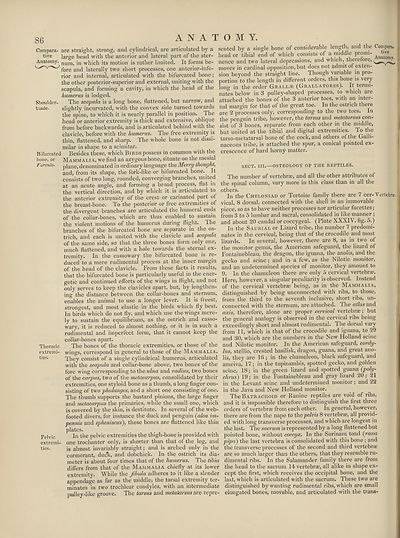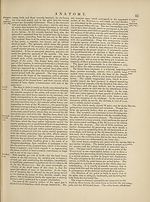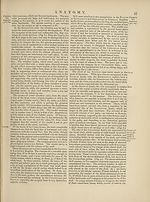Encyclopaedia Britannica > Volume 3, Anatomy-Astronomy
(94) Page 86
Download files
Complete book:
Individual page:
Thumbnail gallery: Grid view | List view

86
ANATOMY.
Compara- are straight, strong, and cylindrical, are articulated by a
tive large head with the anterior and lateral part of the ster-
Anatomy. num> in which its motion is rather limited. It forms be
Shoulder-
blade.
Furcula.
fore and laterally two short processes, one anterior-infe¬
rior and internal, articulated with the bifurcated bone;
the other posterior-superior and external, uniting with the
scapula, and forming a cavity, in which the head of the
humerus is lodged.
The scapula is a long bone, flattened, but narrow, and
slightly incurvated, with the convex side turned towards
the spine, to which it is nearly parallel in position. The
head or anterior extremity is thick and extensive, oblique
from before backwards, and is articulated behind with the
clavicle, before with the humerus. The free extremity is
thin, flattened, and sharp. The whole bone is not dissi¬
milar in shape to a scimitar.
Bifurcated Besides these, which Birds possess in common with the
bone, or Mammalia, we find an azygous bone, situate on the mesial
plane, denominated in ordinary language the .Mem/ thought,
and, from its shape, the fork-like or bifurcated bone. It
consists of two long, rounded, converging branches, united
at an acute angle, and forming a broad process, flat in
the vertical direction, and by which it is articulated to
the anterior extremity of the crest or carinated part of
the breast-bone. To the posterior or free extremities of
the divergent branches are articulated the humeral ends
of the collar-bones, which are thus enabled to sustain
the violent motions of the humerus during flight. The
branches of the bifurcated bone are separate in the os¬
trich, and each is united with the clavicle and scapula
of the same side, so that the three bones form only one,
much flattened, and with a hole towards the sternal ex¬
tremity. In the cassowary the bifurcated bone is re¬
duced to a mere rudimental process at the inner margin
of the head of the clavicle. From these facts it results,
that the bifurcated bone is particularly useful in the ener¬
getic and continued efforts of the wings in flight, and not
only serves to keep the clavicles apart, but, by lengthen¬
ing the distance between the collar-bones and sternum,
enables the animal to use a longer lever. It is freest,
strongest, and most elastic in the birds which fly best.
In birds which do not fly, and which use the wings mere¬
ly to sustain the equilibrium, as the ostrich and casso¬
wary, it is reduced to almost nothing, or it is in such a
rudimental and imperfect form, that it cannot keep the
collar-bones apart.
The bones of the thoracic extremities, or those of the
wings, correspond in general to those of the Mammalia.
They consist of a single cylindrical humerus, articulated
with the scapula and collar-bone above, two bones of the
fore wing corresponding to the ulna and radius, two bones
of the carpus, two of the metacarpus, consolidated by their
extremities, one styloid bone as a thumb, a long finger con¬
sisting of two phalanges, and a short one consisting of one.
The thumb supports the bastard pinions, the large finger
and metacarpus the primaries, while the small one, which
is covered by the skin, is destitute. In several of the web¬
footed divers, for instance the duck and penguin (alca im-
pennis and spheniscus), these bones are flattened like thin
plates.
In the pelvic extremities the thigh-bone is provided with
one trochanter only, is shorter than that of the leg, and
is almost invariably straight; and is arched only in the
cormorant, duck, and dobchick. In the ostrich its dia¬
meter is about four times that of the humerus. The tibia
differs from that of the Mammalia chiefly at its lower
extremity. While the fibula adheres to it like a slender
appendage as far as the middle, the tarsal extremity ter¬
minates in two trochlear condyles, with an intermediate
pulley-like groove. The tarsus and metatarsus are repre¬
sented by a single bone of considerable length, and the Compara.
head or tibial end of which consists of a middle piomi- .
nence and two lateral depressions, and which, therefore,
moves in cardinal opposition, but does not admit of exten¬
sion beyond the straight line. Though variable in pro¬
portion to the length in different orders, this bone is very
long in the order Grall.® (Grallatores). It termi¬
nates below in 3 pulley-shaped processes, to which are
attached the bones of the 3 anterior toes, with an inter¬
nal margin for that of the great toe. In the ostiich there
are 2 processes only, corresponding to the two toes. In
the penguin tribe, however, the tarsus and metatarsus con¬
sist of 3 bones, separate from each other in the middle,
but united at the tibial and digital extremities. To the
tarso-metatarsal bone of the cock, and others of the Galli¬
naceous tribe, is attached the spur, a conical pointed ex¬
crescence of hard horny matter.
Thoracic
extremi¬
ties.
Pelvic
extremi¬
ties.
SECT. III.—OSTEOLOGY OF THE REPTILES.
The number of vertebrae, and all the other attributes of
the spinal column, vary more in this class than in all the
others.
In the Cheloniad or Tortoise family there are 7 cer-Vertebra',
vical, 8 dorsal, connected with the shell in an immovable
piece, so as to have neither processes nor articular facettes;
from 3 to 5 lumbar and sacral, consolidated in like manner ;
and about 20 caudal or coccygeal. (Plate XXXIV. fig. 5.)
In the Saurial or Lizard tribe, the number 7 predomi¬
nates in the cervical, being that of the crocodile and most
lizards. In several, however, there are 8, as in two of
the monitor genus, the American safeguard, the lizard of
Fontainebleau, the dragon, the iguana, the anolis, and the
gecko and seine; and in a few, as the Nilotic monitor,
and an undetermined species of monitor, they amount to
9. In the chameleon there are only 5 cervical vertebrae.
Here, however, a singular peculiarity is observed. Instead
of the cervical vertebrae being, as in the Mammalia,
distinguished by being unconnected with ribs, to those,
from the third to the seventh inclusive, short ribs, un¬
connected with the sternum, are attached. The atlas and
axis, therefore, alone are proper cervical vertebrae; but
the general analogy is observed in the cervical ribs being
exceedingly short and almost rudimental. The dorsal vary
from 11, which is that of the crocodile and iguana, to 29
and 30, which are the numbers in the New Holland seine
and Nilotic monitor. In the American safeguard, cordy-
lus, stellio, crested basilisk, dragon, guana, and great ano¬
lis, they are 16 ; in the chameleon, black safeguard, and
ameiva, 17 ; in the tupinambis, spotted gecko, and golden
seine, 18; in the green lizard and spotted guana {poly-
chrus) 19; in the Fontainebleau and gray lizard 20; 21
in the Levant seine and undetermined monitor; and 22
in the Java and New Holland monitor.
The Batraciioid or Ranine reptiles are void of ribs,
and it is impossible therefore to distinguish the first three
orders of vertebrae from each other. In general, however,
there are from the nape to the pelvis 8 vertebrae, all provid¬
ed with long transverse processes, and which are longest in
the last. The sacrum is represented by a long flattened but
pointed bone, without coccyx. In the Surinam toad (rana
pipa) the last vertebra is consolidated with this bone ; and
the transverse processes of the second and third vertebrae
are so much larger than the others, that they resemble ru¬
dimental ribs. In the Salamander family there are from
the head to the sacrum 14 vertebrae, all alike in shape ex¬
cept the first, which receives the occipital bone, and the
last, which is articulated with the sacrum. These two are
distinguished by wanting rudimental ribs, which are small
elongated bones, movable, and articulated with the trans-
ANATOMY.
Compara- are straight, strong, and cylindrical, are articulated by a
tive large head with the anterior and lateral part of the ster-
Anatomy. num> in which its motion is rather limited. It forms be
Shoulder-
blade.
Furcula.
fore and laterally two short processes, one anterior-infe¬
rior and internal, articulated with the bifurcated bone;
the other posterior-superior and external, uniting with the
scapula, and forming a cavity, in which the head of the
humerus is lodged.
The scapula is a long bone, flattened, but narrow, and
slightly incurvated, with the convex side turned towards
the spine, to which it is nearly parallel in position. The
head or anterior extremity is thick and extensive, oblique
from before backwards, and is articulated behind with the
clavicle, before with the humerus. The free extremity is
thin, flattened, and sharp. The whole bone is not dissi¬
milar in shape to a scimitar.
Bifurcated Besides these, which Birds possess in common with the
bone, or Mammalia, we find an azygous bone, situate on the mesial
plane, denominated in ordinary language the .Mem/ thought,
and, from its shape, the fork-like or bifurcated bone. It
consists of two long, rounded, converging branches, united
at an acute angle, and forming a broad process, flat in
the vertical direction, and by which it is articulated to
the anterior extremity of the crest or carinated part of
the breast-bone. To the posterior or free extremities of
the divergent branches are articulated the humeral ends
of the collar-bones, which are thus enabled to sustain
the violent motions of the humerus during flight. The
branches of the bifurcated bone are separate in the os¬
trich, and each is united with the clavicle and scapula
of the same side, so that the three bones form only one,
much flattened, and with a hole towards the sternal ex¬
tremity. In the cassowary the bifurcated bone is re¬
duced to a mere rudimental process at the inner margin
of the head of the clavicle. From these facts it results,
that the bifurcated bone is particularly useful in the ener¬
getic and continued efforts of the wings in flight, and not
only serves to keep the clavicles apart, but, by lengthen¬
ing the distance between the collar-bones and sternum,
enables the animal to use a longer lever. It is freest,
strongest, and most elastic in the birds which fly best.
In birds which do not fly, and which use the wings mere¬
ly to sustain the equilibrium, as the ostrich and casso¬
wary, it is reduced to almost nothing, or it is in such a
rudimental and imperfect form, that it cannot keep the
collar-bones apart.
The bones of the thoracic extremities, or those of the
wings, correspond in general to those of the Mammalia.
They consist of a single cylindrical humerus, articulated
with the scapula and collar-bone above, two bones of the
fore wing corresponding to the ulna and radius, two bones
of the carpus, two of the metacarpus, consolidated by their
extremities, one styloid bone as a thumb, a long finger con¬
sisting of two phalanges, and a short one consisting of one.
The thumb supports the bastard pinions, the large finger
and metacarpus the primaries, while the small one, which
is covered by the skin, is destitute. In several of the web¬
footed divers, for instance the duck and penguin (alca im-
pennis and spheniscus), these bones are flattened like thin
plates.
In the pelvic extremities the thigh-bone is provided with
one trochanter only, is shorter than that of the leg, and
is almost invariably straight; and is arched only in the
cormorant, duck, and dobchick. In the ostrich its dia¬
meter is about four times that of the humerus. The tibia
differs from that of the Mammalia chiefly at its lower
extremity. While the fibula adheres to it like a slender
appendage as far as the middle, the tarsal extremity ter¬
minates in two trochlear condyles, with an intermediate
pulley-like groove. The tarsus and metatarsus are repre¬
sented by a single bone of considerable length, and the Compara.
head or tibial end of which consists of a middle piomi- .
nence and two lateral depressions, and which, therefore,
moves in cardinal opposition, but does not admit of exten¬
sion beyond the straight line. Though variable in pro¬
portion to the length in different orders, this bone is very
long in the order Grall.® (Grallatores). It termi¬
nates below in 3 pulley-shaped processes, to which are
attached the bones of the 3 anterior toes, with an inter¬
nal margin for that of the great toe. In the ostiich there
are 2 processes only, corresponding to the two toes. In
the penguin tribe, however, the tarsus and metatarsus con¬
sist of 3 bones, separate from each other in the middle,
but united at the tibial and digital extremities. To the
tarso-metatarsal bone of the cock, and others of the Galli¬
naceous tribe, is attached the spur, a conical pointed ex¬
crescence of hard horny matter.
Thoracic
extremi¬
ties.
Pelvic
extremi¬
ties.
SECT. III.—OSTEOLOGY OF THE REPTILES.
The number of vertebrae, and all the other attributes of
the spinal column, vary more in this class than in all the
others.
In the Cheloniad or Tortoise family there are 7 cer-Vertebra',
vical, 8 dorsal, connected with the shell in an immovable
piece, so as to have neither processes nor articular facettes;
from 3 to 5 lumbar and sacral, consolidated in like manner ;
and about 20 caudal or coccygeal. (Plate XXXIV. fig. 5.)
In the Saurial or Lizard tribe, the number 7 predomi¬
nates in the cervical, being that of the crocodile and most
lizards. In several, however, there are 8, as in two of
the monitor genus, the American safeguard, the lizard of
Fontainebleau, the dragon, the iguana, the anolis, and the
gecko and seine; and in a few, as the Nilotic monitor,
and an undetermined species of monitor, they amount to
9. In the chameleon there are only 5 cervical vertebrae.
Here, however, a singular peculiarity is observed. Instead
of the cervical vertebrae being, as in the Mammalia,
distinguished by being unconnected with ribs, to those,
from the third to the seventh inclusive, short ribs, un¬
connected with the sternum, are attached. The atlas and
axis, therefore, alone are proper cervical vertebrae; but
the general analogy is observed in the cervical ribs being
exceedingly short and almost rudimental. The dorsal vary
from 11, which is that of the crocodile and iguana, to 29
and 30, which are the numbers in the New Holland seine
and Nilotic monitor. In the American safeguard, cordy-
lus, stellio, crested basilisk, dragon, guana, and great ano¬
lis, they are 16 ; in the chameleon, black safeguard, and
ameiva, 17 ; in the tupinambis, spotted gecko, and golden
seine, 18; in the green lizard and spotted guana {poly-
chrus) 19; in the Fontainebleau and gray lizard 20; 21
in the Levant seine and undetermined monitor; and 22
in the Java and New Holland monitor.
The Batraciioid or Ranine reptiles are void of ribs,
and it is impossible therefore to distinguish the first three
orders of vertebrae from each other. In general, however,
there are from the nape to the pelvis 8 vertebrae, all provid¬
ed with long transverse processes, and which are longest in
the last. The sacrum is represented by a long flattened but
pointed bone, without coccyx. In the Surinam toad (rana
pipa) the last vertebra is consolidated with this bone ; and
the transverse processes of the second and third vertebrae
are so much larger than the others, that they resemble ru¬
dimental ribs. In the Salamander family there are from
the head to the sacrum 14 vertebrae, all alike in shape ex¬
cept the first, which receives the occipital bone, and the
last, which is articulated with the sacrum. These two are
distinguished by wanting rudimental ribs, which are small
elongated bones, movable, and articulated with the trans-
Set display mode to:
![]() Universal Viewer |
Universal Viewer | ![]() Mirador |
Large image | Transcription
Mirador |
Large image | Transcription
Images and transcriptions on this page, including medium image downloads, may be used under the Creative Commons Attribution 4.0 International Licence unless otherwise stated. ![]()
| Encyclopaedia Britannica > Encyclopaedia Britannica > Volume 3, Anatomy-Astronomy > (94) Page 86 |
|---|
| Permanent URL | https://digital.nls.uk/193758570 |
|---|
| Attribution and copyright: |
|
|---|---|
| Shelfmark | EB.16 |
|---|---|
| Description | Ten editions of 'Encyclopaedia Britannica', issued from 1768-1903, in 231 volumes. Originally issued in 100 weekly parts (3 volumes) between 1768 and 1771 by publishers: Colin Macfarquhar and Andrew Bell (Edinburgh); editor: William Smellie: engraver: Andrew Bell. Expanded editions in the 19th century featured more volumes and contributions from leading experts in their fields. Managed and published in Edinburgh up to the 9th edition (25 volumes, from 1875-1889); the 10th edition (1902-1903) re-issued the 9th edition, with 11 supplementary volumes. |
|---|---|
| Additional NLS resources: |
|

